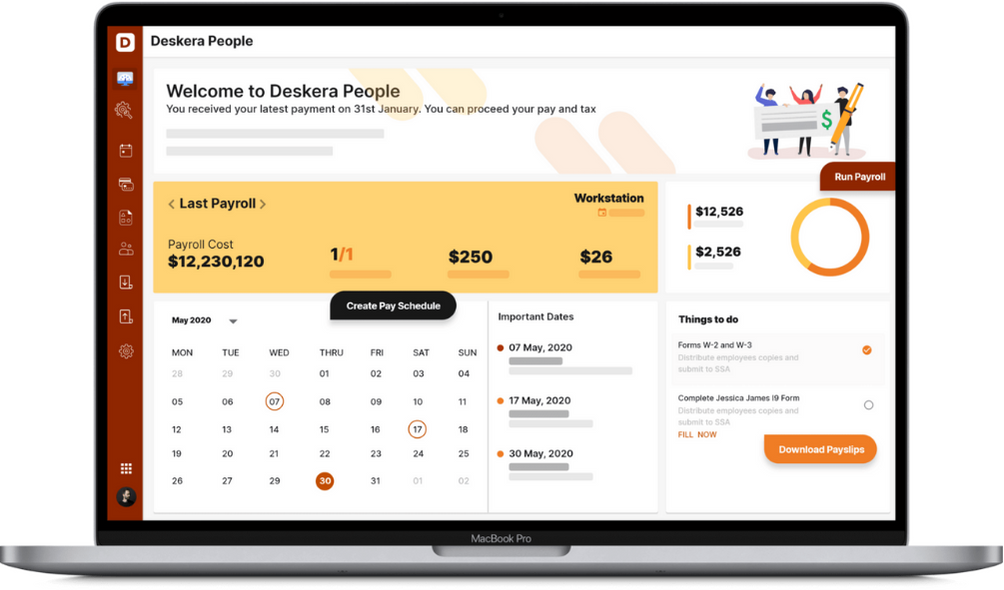When a kid is born, it’s important for both the parents to be together during the initial time of his/ her birth. For this, they need a good paternity leave policy in their business organization. A paternity leave means when a father or spouse takes time off work after their kid is born.
According to studies, parents who take parental leave build deeper ties with their children and give emotional and physical support to new mothers.
Also, according to the Unicef report of 2019, it was analyzed that world’s wealthiest countries are most family friendly. Estonia stands #1 in the list as it provides nearly 80 weeks of paid leaves to the new moms. And, the US is the last one when it comes to parental leaves.
Let’s understand the importance of a parental leave policy and other key information related to this in deep.
Parental Leave: An Introduction
Parental leave is when a father or partner takes time off work following the birth or adoption of their kid to bond with the child and assist the mother.
Parental leave provides a number of advantages for both fathers and non-parenting parents: According to studies, men who take time off work following the birth of a child bond better with their kid both immediately and over time. Paternity leave has also been proven to promote more fair parenting responsibilities, with partners being more active in childcare and household chores.
Parental leave offers emotional advantages for the mother as well. New parents who had their spouse at home for extended periods of time following the delivery experienced less physical and mental burden when caring for a newborn, according to studies.
There are no federally required paid incentives for parental leave in the United States, similar to maternity leave, which is an obstacle for individuals who can't afford to take unpaid time off. There are only six nations in the world who do not have a national paid family leave policy, one among them is the United States – and it’s also the only high-income country –
There is legislation in the works to address this by establishing four weeks of paid family leave, but there is still more work to be done.
Parental Leave Policy: An Overview
The United States is now one of the main developed countries without a paid parental leave policy. However, they do have the Family and Medical Leave Act, or FMLA, which limits employers what they can and cannot do with unpaid leave.
Companies with 50 or more workers (located within 75 miles of an office or worksite) must provide new parents with up to 12 weeks of unpaid leave over the span of a year, according to the FMLA. This law applies to all full-time employees, regardless of gender, who have worked for their company for at least 1,250 hours before to taking leave.
Various state restrictions, on top of the federal FMLA provision, add even more weight. Companies must give paid leave in Massachusetts, California, Rhode Island, and New Jersey, for example, therefore the "unpaid" aspect of the federal law does not apply.
Benefits of Providing Paid Parental Leave
Aside from the numerous advantages of providing paid parental leave to employees, there are also perks for company owners. Employee morale and engagement are likely to be better in companies that provide paid leave. Because of improved job quality, productivity, and staff retention, these organisations frequently surpass the competitors monetarily.
Offering paid parental leave can help you attract and retain top talent while also demonstrating your commitment to establishing a diverse and inclusive company. Employee satisfaction, engagement, and financial performance frequently improve when organisations are diverse and inclusive.
Best Practices to Consider for Creating a Parental Leave Policy
To assist you decide on the appropriate parental leave policy for your firm, use the best practises listed below:
- Investigate how other firms across the world handle parental leave.
Keep track of the parental leave businesses in the nations where your firm does business or recruits overseas personnel. Try to match your company's parental leave policy to that of your employees' home nation.
Consider both parents' requirements
Take into account both parents when developing your parental leave policy, and attempt to give them with equivalent perks. Consider providing parental leave to both parents because both moms and fathers are often involved in the nurturing of their children (and all of the sleepless hours and early mornings that entails).
Explain parental leave policy to workers in detail and be prepared to answer queries
Hold a meeting with your workers to review the regulations of your parental leave policy once you've written or updated it. Prepare for any queries that employees may have by detailing each section. When answering inquiries and listening to employee concerns, be patient.
Hold a meeting with your workers to review the regulations of your parental leave policy once you've written or updated it. Prepare for any queries that employees may have by detailing each section. When answering inquiries and listening to employee concerns, be patient.
Who Can Apply for a Parental Leave?
Parental leave is only available to employees who have parental responsibilities (unless the employer permits individuals without parental responsibility to take such leave).
This implies they must be the kid's biological parent (whether or not they live with the child), adoptive parent, or have (or intend to have) legal parental responsibility for the child in some other way, such as through a surrogacy agreement (eg be the legal guardian).
Foster parents are usually only eligible for parental leave if they have taken legal custody of the kid. Unless they have properly gained parental responsibility, a child's stepparent is often not entitled to parental leave for the kid (eg adopted the child).
If it is fair to do so, the employer might request reasonable proof of parental responsibility (e.g., a birth certificate). Employers, for example, cannot demand documentation every time an employee asks leave.
Setting-Up an Effective Parental Leave Policy (with examples)
Having an effective parental leave policy will not only be beneficial for the employee, but will also improve the working environment of the organization, boost the morale of other employees, and motivate them to give their best.
Let’s have a deep knowledge about setting up an effective parental leave policy.
Provide Room For Flexibility
Some employers enable parents to take time off when they need it the most, whether before or after the birth of their kid.
Employees can take up to 12 weeks off throughout a 12-month period under FMLA criteria, which they can stretch out before or after the birth or adoption, or when foster care begins.
You can also enable individuals to take their leave in portions so that they can take it at different times during the year after the new child is born.
Allow your staff to be inventive. To stretch out the amount of time they don't have or spend for child care, they can start with three- to four-day workweeks in the beginning, or take leave when their co-parent isn't taking theirs. You might also consult them before drafting your parental leave policy. This flexibility allows for a more deliberate return to work.
Determine Who’s a Parent
So, who is eligible to take parental leave? Include these facts in your policy, and don't forget to state when parental leave is not applicable. Are both parents, for example, eligible for the benefit if they both work for your company?
Here are a few suggestions of how "parent" may be defined:
- Biological parents, same-sex partners
- Step-dad/ step-mom
- Foster parent
- Adoptive parent
It's also a good opportunity to see whether you identify an employee as a parent in some circumstances but not others. Does your organisation, for example, enable a stepparent to add a new stepchild to their health insurance plan but not to take parental leave to connect with them? Consider making changes to your policies so that they are uniform across the board.
Think About Implementing A "Leave Share" Concept
Amazon introduced an interesting change to their policy in 2015, allowing parents to share leave with their spouses.
Employees can share up to six weeks of paid leave with a spouse under the scheme, as long as the partner does not get the benefit from their own company.
Keep the Transition Easy
A transition programme can make it simpler for individuals to get back into the flow of things.
It can also improve the chances of a parent returning to work.
Alston & Bird, an Atlanta law firm, has devised a programme that pairs new parents with mentors once they return from maternity leave. Most of the mentors have previously gone through the process of having a kid, so they'll be able to provide plenty of advice as new moms get back on their feet. Your own policy may provide mentorship to any parent who chooses to take use of the leave benefit.
Another alternative is to give new parents the option of working from home or part-time as soon as they return.
Amazon has a specialised "ramp back" programme, in which employees can return part-time at first and then gradually increase their hours to full-time. Spotify's "Welcome Back!" initiative provides all full-time workers with flexible work alternatives, including the chance to work from home, part-time, or at different hours.
The change may be made much easier if you take it slowly.
Focus on Being Gender Neutral
Do you have any idea what rocks? The reality that each and every family is unique. As a result, make sure your policy reflects this reality.
Rather than singling out a specific gender or family dynamic, ensure the language and standards you establish are universal.
Examine Your Policy to See If It Encourages Equitable Pay
While taking time off to bond with your newborn baby is crucial, some evidence suggests that time away from work is linked to reduced income. Women are also more likely to experience the impacts of wage gap since they are more likely to take maternity leave.
However, when both parents share child care, the playing field is levelled. Create an inclusive parental leave policy that promotes all parents, regardless of gender, sexuality, or family structure, to take time off. For instance, your parental leave plan may include:
- Paid time off for the parent who gives birth in order to recuperate.
- An extended compensated bonding period is provided to both parents.
- Money to help with adoption costs.
- For all parents who have taken time off, there is a back-to-work transition programme.
- Throughout the parental leave, employees' 401(k) contributions are matched, with a continuous equity vesting plan.
- Subsidies for child care to assist parents with the financial burden of returning to work.
Make It An Occasion to Celebrate
Many firms provide bonuses as part of the pregnancy package. Domo, a Utah-based software business, is giving moms $2,000 to spend on maternity apparel in the months leading up to the big day.
They also pay each co-parent $1,000 to help with the additional costs.
Document the Information in Your Employee Handbook
One of the most critical methods to keep your employees pleased is to have a sensible parental leave policy. Once you've wrapped up the specifics of your policy, get it reviewed by an HR specialist before slipping it into your employee handbook. It should contain logistical information like:
- How to submit an application for parental leave.
- Requirements for eligibility, such as completing a certain number of hours of service.
- The max number of weeks an employee can work in a certain period of time.
- Whether or not benefits are reduced if numerous births or adoptions occur within a 12-month period.
- If the employee needs to use up other paid time off before taking parental leave, such as vacation and sick time.
- Whether or whether the employee will be compensated. If that's the case, what might they anticipate in terms of pay?
- If a parent is on paid leave, when may they expect to get paid?
- If the policy is applicable to union employees.
- Whether or not parental leave and FMLA leave will run simultaneously.
After that, make sure that everyone, including parents and non-parents, has access to the most recent version.
Revise Your Policy on a Consistent Basis
Keep an eye out for laws affecting this benefit. You'll need to make sure your company is compliant if your city or state starts enforcing paid leave or changes the rules around it.
You could also make adjustments depending on what works and what doesn't. Employees may make suggestions for how you might improve the team's value.
Put Your Words Into Action
Regardless of their position, every employed person should reap the benefits of their company's parental leave programme. This sends a message to the entire team that taking it is not only OK, but encouraged.
Every business should safeguard parental leave, and every qualified employee should take advantage of it.
Get to work on a policy that is compliant, authentic to you, and beneficial to your team. Then watch as everyone becomes much more at ease (and ecstatic!) when their little ones make their grand entrances into the world.
How can Deskera Help You?
Deskera People allows you to conveniently manage leave, attendance, payroll, and other expenses. Generating pay slips for your employees is now easy as the platform also digitizes and automates HR processes.

Key Takeaways
- A parental leave means when a father or spouse takes time off work after their kid is born.
- According to a 2019 Unicef report, it was analyzed that world’s wealthiest countries are most family friendly. Where Estonia is #1 and the US stands at the last position.
- The United States is one of the major developed countries without a paid parental leave policy.
- Employee satisfaction, engagement, and financial performance frequently improve when organisation focuses on creating necessary policies like parental leave policy for its employees.
- There are 3 best practices to formulate a parental leave policy for your organization: check how othet firms have created the policy, give importance to both the parents, and brief about your policy to your employees and solve their queries.
- Parents with legit parental responsibilities can apply for paid parental leave policy in their organization and they might have to submit documents to support themselves.
Related Articles












